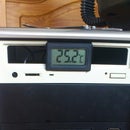Introduction: Monitor Stand
Why do (cheap) monitors always come with such tiny stands? Why are VESA mounts so expensive?
I don't know, but I do know how to solve this.
In this instructable I will show you how I built a simple but functional monitor stand that will better your monitor's viewing position, create more desk space and hopefully doesn't ruin the look of your battlestation.
Step 1: Preparation
Maybe the most important part of a bigger project is the design. So make sure to not skip this part :)
Measuring
What you need to measure depends on your purpose, here's what I measured:
- Height from table surface to desired monitor height
- Width and depth of the factory fitted monitor stand
- Keyboard width (so I can slide my keyboard below the stand)
Design
In SketchUp I drew a concept of the stand I hoped to build. You can find monitors and keyboards to fit in your model in the 3D Warehouse.
If you're happy with the design, then gather the materials.
Materials needed
- Wooden or plywood plank
- Wooden dowels (x4)
- LED strip (optional)
Tools
- Saw (table saw preferred over hand saw)
- Sander
- Sanding paper
- Drill
- Try square
- Tape measure
Step 2: Building
Sawing
First saw your top plate to the desired width. Mark the saw line as straight as possible, and make sure it's perpendicular to the edge.
Then use the rest of the material to make the 'legs'. You can also use a different material if that's the look you're going for. Here it is even more important to saw straight, perpendicular and to make sure both legs are of the same length.
Sanding
Depending on how good you can saw and what saw you used, this may take some time. The edges of the top plate only have to be smoothed to prevent injury. The legs however will need more sanding. Keep sanding them until both edges are straight. Test this on a flat surface, at least the legs should be able to stand upright on a flat surface.
Dowels
Next, you'll want to attach the legs to the plate. There are more ways to do this, glue, screws, nails are also an option, but I chose to use dowel, so that I could take the stand apart for transportation and adjustments.
Mark holes on the legs, I set them 2 centimeter from the outer edge, and be very precise with this. Then put your dowels in the holes. Placing the holes on the plate is a bit trickier, but if you measured and drilled precisely, it should fit together.











